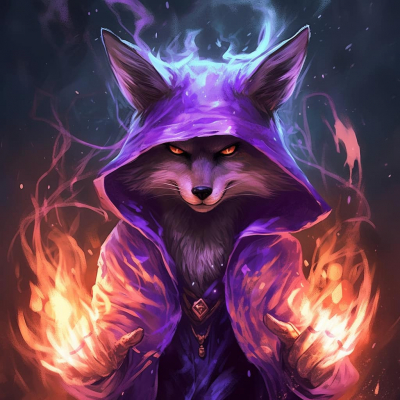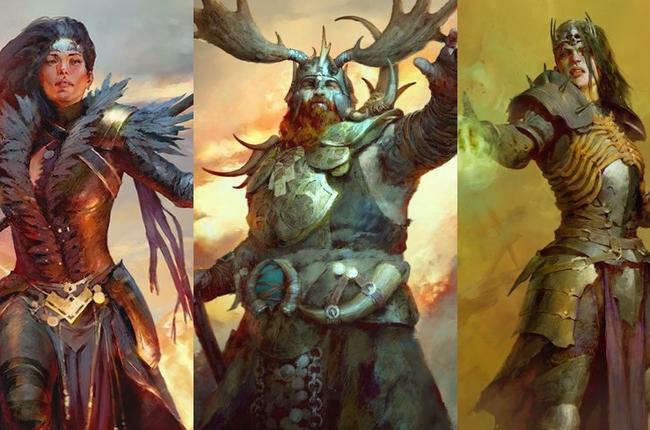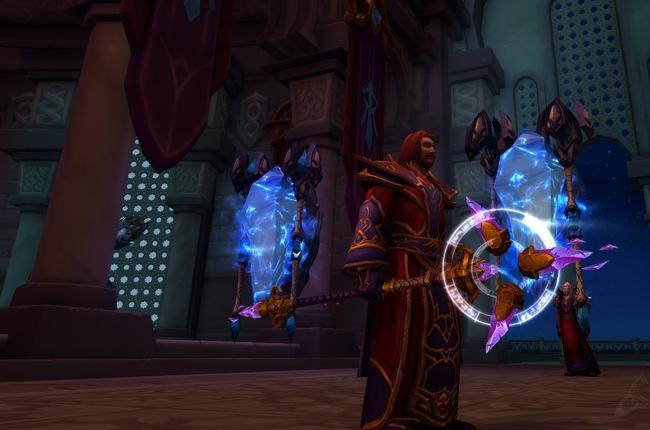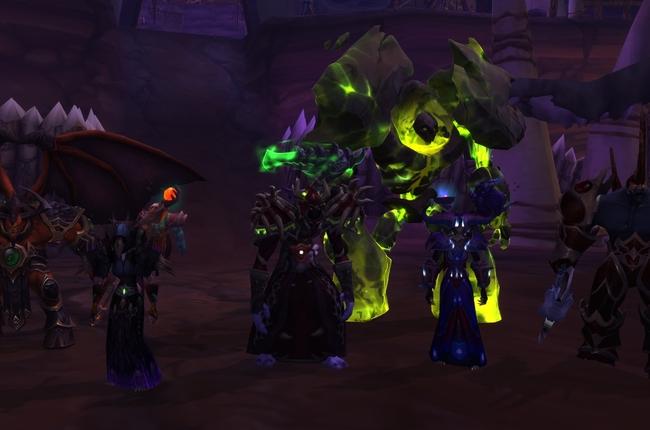Reflection on Shadow Priest in Dragonflight & War Within Wishlist - Editorial
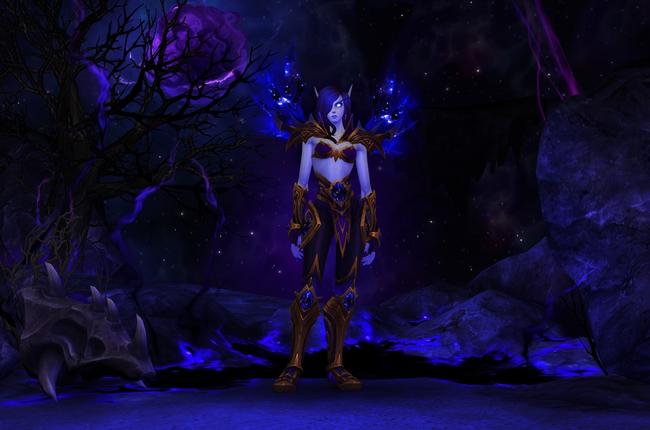
With the sun setting on Dragonflight and The War Within on the horizon, our Shadow Priest Writer, Ellipsis, offers a retrospective highlighting Shadow's journey in Dragonflight and shares their hopes for the spec's next evolution with a War Within Wishlist. Frost DK, Havoc DH, Restoration Druid, Augmentation Evoker, BM Hunter, Fire Mage, Mistweaver Monk, Protection Paladin, Assassination Rogue, Subtlety Rogue, Elemental Shaman, Restoration Shaman, Affliction Warlock. Shadow Priest's Journey Through Dragonflight
Shadow Priest has been on somewhat of a viability roller-coaster throughout Dragonflight, going from some of the highest highs of any spec to relative obscurity and back again. This article is going to go over how the spec evolved throughout the expansion, the way the game changed to both help and hinder it, and discuss potential pain points raised across both Raiding and Mythic+. Before we dive into specific topics though, here is a quick summary of the state of Shadow Priest throughout Dragonflight up until 10.2.5.
During the PTR, Shadow Priest, alongside the Priest class as a whole, was one of the first Talent Trees revealed during the early stages of Dragonflight Development. The initial talent tree was widely disliked and criticisms ranged from a lack of cohesion for what the spec was trying to do or be, to difficulty finding use cases for many of the talents. It felt more like a proof of concept for talent trees themselves, and less like a thought out spec. Thankfully both the class and spec trees saw a lot of iteration throughout Beta and came to the live game in a much healthier state than when they were initially revealed.
In Season 1, Shadow had a rocky start. Due to poor Single Target tuning, incredibly weak DoTs and spread cleave, and a lack of movement tools, Shadow saw very little high end play in both raids and Mythic+ for the first few months. Another major factor that impacted Shadow's viability in Vault of the Incarnates, was the extremely heavy movement requirement for many of the bosses, particularly Raszageth who, in her initial Mythic Incarnation, was lethal for Shadow without the use of an Evoker's Rescue spell at multiple points throughout the fight.
Shadow received multiple rounds of buffs throughout Season 1, most notably buffs to Psychic Link's spread damage to include damage dealt by both Void Bolt and Void Torrent. After these buffs, as well as changes to some of the more demanding Mythic raid encounters, Shadow's popularity and strength in PvE content began to rise, and by the end of the tier Shadow was one of the strongest DPS choices for Mythic+.
While Shadow did end the first tier in a strong spot, it took a while to get there. Despite feeling smooth enough in skilled hands, the spec was very busy, with a lot of procs to manage and a large number of active abilities. For this reason, a rework was announced to Shadow's kit. Removing Mind Sear and mind spike procs, in favor of a single filler choice and AoE gameplay centered around Psychic Link.
In Season 2, the initial tuning of the rework meant Shadow Priest was once again lacking in Single Target, though what it lacked on fights like Rashokit made up for on Sarkareth, earning it a consistent spot throughout World First progression. Shadow's unique damage pattern of high priority target with low opportunity cost AoE was perfect for the Aberrus raid, as well as Mythic+, and Shadow was firmly the strongest and most popular DPS spec for high keys in the first months of 10.1.
In patch 10.0.5 Shadow received some buffs aimed at improving its poor Single Target damage performance in raids. These buffs had a knock on effect on AoE through Psychic Link, and pushed Shadow even higher in Mythic+, becoming 1/3 of the DPS God Comp comprised of Shadow Priest, Fire Mage, and Augmentation Evoker. Shadow received multiple damage nerfs throughout this period which heavily impacted its AoE damage.
Shadow ended the season still a part of God Comp, though now it was more often brought for its incredibly valuable utility, including Mass Dispel, Mind Soothe, and Power Infusion, and less for the raw damage the spec brought. Before Season 3 launched, Blizzard announced they would be nerfing Mass Dispel to a 2 minute cooldown, as well as reducing both the effectiveness of Power Infusion and reworking some its largest beneficiaries to reduce its value. These changes also came with more nerfs to both Shadow's resource generation and its damage.
Season 3 started badly for Shadow. The nerfs that had come throughout Season 2 were compounded by the removal of the season's set bonus, and a shift towards a Single Target talent kit with less incidental AoE damage. Shadow's poor tuning and weakened utility meant that it saw no play in the Amirdrassil World First race, and fell out of the Mythic+ meta.
The spec has been receiving intermittent buffs and tuning to both its AoE and Single Target damage, and as the season has progressed has found its feet to be a strong Mythic+ option. However it still suffers in raid due to mediocre Single Target and a complete lack of reliable high target burst DPS. Tindral Sageswift, particularly for example, is a fight where high burst AoE and movement requirements do not play to its strengths.
After many ups and downs, Shadow sits in an awkward spot. Its sustained AoE in high end keys is strong but it can be cumbersome to play and lacks the burst needed to feel good at lower levels. Its Single Target is relatively weak but tuning is tied directly to its AoE through Psychic Link. Its utility consists of a few unique niche spells on long cooldowns, meaning their relevance is heavily tied to encounter design. Shadow has followed a trend every patch of starting off weak, receiving buffs for raid performance that push it over the top in Mythic+, then receiving nerfs to rein it back in until the next patch, when the cycle starts anew. This cycle of buffs and nerfs means the spec has received a disproportionate amount of developer attention throughout the expansion and, despite being a poor choice for those raiding in top end guilds, has rarely stayed bad for all that long.
Power Infusion and the impact of externals
One of the biggest changes all Priests received in the initial Dragonflight talent trees was the addition of the Twins of the Sun Priestess legendary as a talent for all specs. This meant that Shadow Priests would be both able and expected to cast their Power Infusion on an ally instead of themselves every 2 minutes. The impact of this change on Shadow's viability in all content cannot be understated. The amount of damage provided by Power Infusion when it's used on an optimal target can often make up for the spec's own somewhat lacking Single Target. Shadow however, was never explicitly tuned around the existence of Power Infusion, instead having it be considered part of its niche but potent utility kit. Power Infusion was an effective tool for Shadow to make up the performance difference in multiple raid tiers this expansion, however where it truly shined was in Mythic+ where Shadow's own damage contribution was already strong.
With the introduction of Augmentation Evoker in 10.1.5, Shadow became even stronger, as it was now possible to load up multiple external buffs on powerful burst classes during their cooldowns. This also sparked a debate around the impact of externals on gameplay telemetry and parse culture, as well as questions about how fun is it to play a class that feels overly reliant on external buffs to either perform adequately or feel good to play. Between Breath of Eons and Power Infusion, Mythic+ comps had the tools to deal incredible burst damage every two minutes and wipe out enormous trash pulls.
Power Infusion's strength and ubiquity has had a direct impact on class design, most notably for Fire Mage, Unholy Death Knight, and Demonology Warlock. All three of these specs have received changes in Dragonflight aimed at reducing their burst damage profiles, and to attempt to dissuade external stacking. It's interesting to see that the impact of a spell from one class can be so great that it leads to changes elsewhere in the game.
With Blizzard showing no signs of shying away from external damage abilities as the game progresses, it's unlikely we'll ever see Power infusion return to being a self buff on the priest or anything similar. External buffs are here to stay for the foreseeable future, and, in theory, that should suit Shadow quite well. In the past, the spec has struggled to find a purpose in raid compositions besides when its been designed around performing in spread cleave. As long as Shadow is not deliberately under-tuned due to Power Infusion, it should be able to justify a raid spot outside of egregiously poor tuning or fights simply asking Shadow to do things it is not set up to do.
The Reworks
As mentioned earlier, Shadow received a substantial amount of developer attention in Dragonflight from the release of its talent trees all the way up to 10.2.5. While most of that has been in the form of buffs and nerfs to core spells due to its underperformance in raids and over performance in Mythic+, the spec has received two major reworks and a 3rd minor rework during Dragonflight.
Rework 1:
Moving into Dragonflight, Shadow saw substantial changes as part of the talent revamp. Searing Nightmare, the spec's AoE spender during Shadowlands, was removed in favor of changing Mind Sear into a resource-spending, channeled ability. Dragonflight also brought back Mind Spike as a separate single-target filler spell that was made instant cast with ticks of Vampiric Touch. The fan favorite, Mind Flay: Insanity, also returned, buffing Mind Flay after every cast of Devouring Plague.
Dark Ascension also came back to offer an alternative damage cooldown to Voidform, and Shadow Crash was reworked into a reliable way to mass apply both maintenance damage over time spells. This rework came with the tagline "Build your own Shadow Priest" and tried to marry together the more recent design of Shadowlands with a lot of features Shadow hadn't had access to since Cataclysm and Mists of Pandaria.
Despite being functional, it created a very busy rotation. Instead of picking and choosing what aspects of Shadow's previous designs you wanted to use, you instead were incentivized to use all of them. For experienced players, this was no problem; however, it did give rise to discussion surrounding button bloat within the wider community. On top of that, for as much as players supported Shadow Crash being reworked into a way to apply their DoTs, the initial cooldown was long and didn't line up very effectively for Mythic+ keys where packs were dying too quickly. The experience playing Shadow as a new player, especially in lower content, was arguably not a pleasant one, so Shadow received details of a rework going into patch 10.1 that aimed to streamline the AoE and Single Target gameplay.
Rework 2:
The results of the streamlining were the removal of Mind Sear as a spender, the addition of Devouring Plague to Psychic Link in order for Devouring Plague to function as a spender on both Single Target and AoE, the reduction of Shadow Crash's cooldown to 20 seconds to allow players to consistently reapply DoTs in AoE without having to resort to manually casting Vampiric Touch, the consolidation of Mind Flay and Mind Spike into a single spell choice, and the addition of Mind Spike to the effects of Surge of Insanity. Altogether these changes resulted in the gameplay experience between Single Target and AoE being nearly identical, as well as a cleaner and more streamlined rotational feel, which opened up more space for Voidform to see play as it was now a lot easier to consistently cast Void Bolt on cooldown. In losing separate Mind Spike, Shadow lost a large amount of its instant cast Burst damage and some of its mobility. For the most part, this only affected PvP, though it did affect the spec's viability in PvP heavily, especially outside of top end competitive play.
Player response to these changes has been mixed. The reduction in complexity has been seen as both a significant improvement and a huge step backwards depending on your perspective on class design. Despite the goal being to reduce complexity and reduce bloat, spells like Mindgames, which, for Shadow, serve only to be pressed on cooldown and provide little interaction, survived, while things that offered skill expression to use correctly did not. Voidform also has its fair share of detractors, and with it becoming the de facto way to play Shadow for the Majority of Season 2, people had begun to question how effective the idea of "Build your own Shadow Priest" could be. Ultimately how anyone felt about the second rework was overshadowed by the performance of the spec in Mythic+ as a member of God Comp. The mix of highly valued utility for the Season 2 dungeon pool, strong priority target damage with incidental cleave, and Power Infusion to pair with both Augmentation Evoker and Fire Mage meant, regardless of people's thoughts about gameplay, the damage was there and the spec saw unanimous representation in the season's Mythic+ dungeon competitions and events.
Rework 3:
In a further effort to reduce the busyness of Shadow's rotation, the talent Surge of Insanity was altered to provide an empowered cast after every other Devouring Plague cast, instead of after every one. This change also came with a series of other nerfs to both utility and damaging spells. While this is a significantly smaller mechanical change than anything we saw in either of other two reworks, I've chosen to include it because it has had an impact on gameplay beyond just numbers. The consensus among players was that this mechanical change was unnecessary as Shadow had either been trimmed down enough or too much already. The lack of world-beating performance to showcase the spec's strength in higher keys has also meant that a lot more of the gameplay focus for Shadow this season has been focused on lower level keys where the Shadow Crash focused design has problems. The Mythic+ experience for Shadow Priests is currently incredibly polarizing as, while damage is there the higher you go, burstier specs beat you to the punch a lot, and pull cadences don't always line up cleanly with the cooldown of Shadow Crash.
The current design of Shadow hasn't had an opportunity to shine in a Raid environment this tier either, with very little spread cleave to leverage Psychic Link and a strong focus on burst AoE which Shadow does not provide. The recent buffs in 10.2.5 seek to alleviate this, but it will take time to see how much of an impact they will have. For now, it's clear that, while mechanically very little changed between Seasons 2 and 3, performance plays a large role in player perceptions and it's clear there are pain points to be addressed in the future.
Talent Tree
After so many changes to talents throughout Dragonflight, we will look at each talent as it stands in 10.2.5, and how it's been used and thought of throughout the expansion. While the majority of interesting discussion surrounding talents is focused on the spec tree, there are a few key talents in the class tree to cover. Overall, Shadow suffers from the Priest Class Tree since the spec is too disconnected from the role of the other two priest specs. There are talents that no Shadow Priest would ever take under any circumstance such as Inspiration, Prayer of Mending, and Focused Mending. Twins of the Sun Priestess is a talent that has already been discussed briefly. It is a mandatory, powerful talent that has shaped the class in all aspects of the game. Mindgames from a Shadow perspective feels like a bit of a loose end. An ability that exists to be pressed on cooldown and provide a small damage increase, it's one of the largest examples of bloat left in the spec, in my opinion, and while it has value for PvP, there are likely better ways to provide this effect without gumming up the Single Target rotation.
Top Section
Shadow's spec Talent Tree has a large number of nodes in the top section that is focused on utility. This means players aiming for the highest damage builds have to sacrifice something to take them, and as such many have seen very little play this expansion outside of PvP. The rest of the nodes are mandatory damage talents or required for pathing later on.
Devouring Plague is the spec's starting node and resource spender in both Single Target and AoE. Dispersion is a core defensive and mandatory talent choice. Shadowy Apparitions is a mandatory damage talent. Silence is a talent that feels awkward to take in many circumstances, due to its relatively niche use when valued solely as an interrupt. In PvE, a silence is rarely any better than a kick, so Shadow is often sidelined as much as possible from interrupt mechanics due to its long cooldown. Mental Fortitude is the talent taken instead of Silence in most circumstances. Misery is a mandatory talent for damage gain and navigating the tree. Psychic Horror/Last Word is a talent in a sad position in Shadow's talent tree. This talent cannot be taken without costing some amount of damage or Dispersion, the spec's major defensive cooldown. Thought Harvester is a mandatory damage talent. Psychic Link is a mandatory talent as Shadow's only real source of AoE. Surge of Insanity is a mandatory damage talent. From this point on, every talent has seen some use throughout the expansion in PvE with the exception of Unfurling Darkness, which has only ever found use in PvP. Despite this high amount of talent diversity, there's very little gameplay interaction behind many of the options in this section, resulting in a soup of meaningless decisions where the only correct answer is to sim what's best.
Middle Section
The middle section of Shadow's tree also contains two major choice nodes that impact gameplay. However, neither has a particularly well-defined use case, leading to some often counter-intuitive decisions.
Choice Nodes Void Eruption/Dark Ascension is a polarizing node, with a large number of fans and haters on both sides. Distorted Reality/Mind's Eye have both been used in both Single Target and AoE throughout Dragonflight, which feels odd as the one that increases the duration of DOTs should logically lend itself to a Multi Dotting style of gameplay that hasn't really materialized at any point in the expansion, and instead is just used for raw damage output on a Single Target.
Capstone Section
The third section of Shadow's tree is the most distinct and interesting, there are clear themes beginning to emerge, such as a focus on Shadowy Apparitions or on Mindbender, as well as fan-favorite spell, Void Torrent. However, this is let down somewhat by mostly uninteresting and convoluted capstones. The concept of four idols representing the four Known Old Gods of Azeroth is peak Shadow Priest flavor, and an inspired decision, however they often fail to capture the player's imagination and end up just being boring, albeit relatively strong, passive effects.
Idol of Y'Shaarji is played in single-target builds focusing on Mindbender. Idol of N'Zoth is an AoE choice modeled off the Echoing Void Corruption ability from Battle for Azeroth. Idol of Yogg-Saron serves as Shadow's main payoff in the apparition-centric build. Idol of C'Thun, while passive, is generally well liked, and a mainstay of every build throughout the expansion. The tentacles have a great visual, the resource generation they provide is visceral, and getting lucky and spawning a large number of them from Void Torrent is something you really feel.
Tier Bonuses
Shadow's tier bonuses have generally been ok once they reached live servers in Dragonflight, however in some cases they often went through significant iteration or reworks on the PTR in order to be something satisfying and enjoyable to play with. Shadow's tier bonuses have, however, highlighted one concern with Dragonflight talent trees: that each bonus has a huge impact on a specific set of talents and generally amplifies them to the forefront of the spec's playstyle. For those who dislike a specific talent combo or playstyle it doesn't feel great to have a significantly weaker set bonus, or in some cases though, thankfully, not Shadow, no set bonus at all.
Set 1: Draconic Hierophant's Finery
- 2-Set-Priest Shadow Class Set 2pc- Mind Blast increases the damage of your next Devouring Plague by 12%, stacking up to 3 times.
- 4-Set-Priest Shadow Class Set 4pc- Devouring Plague increases your haste by 4% for 8 sec.
The initial set bonus for Dragonflight was incredibly basic and didn't rock the boat when it came to talent combos or class design. Set 2: The Furnace Seraph's Verdict had players divided as some loved it while others hated it. Set 3: Blessings of Lunar Communion received mixed reviews and focused heavily on the Mindbender playstyle, as well as having a somewhat thematically detached and awkward 4-set bonus.
Utility, Dungeons, and God Comp
The biggest reason Shadow hit the headlines throughout Dragonflight was for being a part of the Season 2 Mythic+ God Comp. This was a 5-man team composition consisting of a Holy Paladin Healer, Guardian Druid tank, Fire Mage, Augmentation Evoker, and Shadow Priest for DPS. These 5 specs dominated the overall meta for Mythic+ in Season 2, penetrating all levels, from weekly keys to the official Great Push Tournament. While these specs were individually strong in their own right, together they created a perfect storm that was miles ahead of any possible competition.
Defensively, between the un-nerfed versions of Shifting Sands, Glimmer of Light, and the passive buffs from the Evoker, Priest, Paladin, and Druid, a lot of natural bulk and durability was provided to the whole team. While Shadow was not a weak spec defensively, its lack of desire for versatility or passive mitigation has meant that in the past it has struggled in Mythic+ when avoidable damage scales into one-shot territory.
Much like with Protection Paladin in Season 1, Shadow welcomed the addition of Augmentation Evoker to Mythic+; their extensive disruption toolkit made up for Shadow's own lack of AoE stops and control. One of Shadow's historic weaknesses in Mythic+ has always been the lack of AoE mob control, and while Psychic Scream has had its target cap of 5 removed in Dragonflight, it's still pretty low on the totem pole.
With a composition playing to all Shadow's strengths and covering pretty much all of its weaknesses, it's no wonder it saw such extensive play. However the thing that really solidified the need for a priest was how well positioned the class's utility was.
Mass Dispel was either exceptionally powerful or near mandatory in 4 of the 8 Mythic+ dungeons in Season 2, as well as able to near enough negate the Bursting affix. Mind Soothe was able to be used in most dungeons, since they contained large numbers of dragonkin and humanoids with very few other mob types in between. This allowed priests to skip many dangerous trash packs for their groups, as well as complete the cage event in Brackenhide Hollow alone while the group cleared trash for percent.
This utility was so strong that after multiple damage nerfs throughout Season 2 of Dragonflight, it too was nerfed. There are questions about whether these nerfs made sense given how specific they were to the Season 2 dungeon pool in the context of God Comp. We've seen a huge drop-off in the number of mindsoothable trash mobs in Season 3's dungeons, as well as useful places for Mass Dispel.
The War Within Speculation and Hero Talents
With The War Within hype creeping in and speculation rife about the impact and potential of Hero Talents, here are my personal thoughts on what I'd like to see from each of the talent packages relevant to Shadow Priest, as well as some general thoughts on the pain points uncovered for the spec throughout playing it in Dragonflight. As it's not clear which of the three hero talents Shadow is not receiving, I'll be offering some thoughts on what all three might be.
Archon
I'd love to see one of these trees lean into the "Fallen Angel" aesthetic Shadow Priest of old was working with, prior to the inclusion of the Void. While I personally also love the Void themes, I know many do not, and I feel that trying to cram both of these ideas into the same Talent Tree has left shadow often feeling muddled and directionless. Hero Talents seem like a great opportunity to separate those themes, and explore them in more detail without having one steal the limelight from the other. This is also the Hero Talent tree I feel would make the most sense to go hard on Shadowy Apparitions.
Oracle
The least likely to be Shadow adjacent but still always a possibility. I've honestly no real idea what direction this could go in but there's potential for more light themed DPS abilities and Shadow shifting away from Shadowform being a purely cosmetic ability and instead something you manage alongside new light-based effects and damaging abilities. It's very hard to marry the themes of both Shadow and Holy together without accidentally creating Discipline Priest, but this could be a cool avenue to explore.
Voidweaver
Given the current, rather neutered state of Voidform, as well as the potential to explore a deeper connection to the Void with the location and antagonist of the upcoming expansion, this is the hero tree I am the most excited for. As mentioned in my thoughts on the potential of Archon, splitting the "Fallen Angel" and "Void God" themes into two distinct builds, this offers great opportunities to flesh both of them out. I'd love to see some aspects of the frenetic Voidform playstyle from Legion and BFA return, especially now that it seems like they might have a proper home.
Shadow Word: Pain Points
There are three main areas of Shadow Priest class design that I feel need to be addressed as we look towards The War Within.
- AoE gameplay: As well as Shadow Crash might work in optimized high-end environments, putting so much of a spec's total AoE value into a single spell with a medium-length cooldown that can often whiff through no fault of the player, likely isn't the best way forward long-term. Psychic Link's value as a way to provide spread cleave despite weaker overall DoT damage is excellent, but the spec needs ways to deal indiscriminate AoE damage more reliably. Shadow's AoE also currently feels exactly the same to play as it does Single Target, with the only change to rotational priorities being the inclusion of Shadow Crash. While I didn't personally enjoy Mind Sear attempting to fill that role, it's clear something has to when spread cleave isn't cutting it.
- Rethink Utility: After the enormous nerfs all three priest specs received to Mass Dispel, something feels like it needs to fill that void to make sure the class as a whole remains desirable or relevant beyond just tuning and Power Infusion. The fact that Shadow's interrupt and CC are awkwardly positioned in the spec tree also makes for some unfortunate choices that no other specs really have to make. I'd love to see some cool Shadow themed utility spells as well.
- A Call for Cohesion: The tagline for the spec going into Dragonflight was "Build your own Shadow Priest" aiming to appease two very different thematic identities within the same talent tree. I feel that, while this ended up taking a backseat to mechanical and tuning issues throughout the expansion, trying to balance two themes in the same tree proved very difficult to get right. It's my hope that with the introduction of Hero Talents, those themes can be properly housed and expanded upon leaving a base Shadow tree with a lot more thematic consistency.
Playing Shadow really has been an experience this expansion, with ups, downs, and everything in between. I'm really hopeful the positive groundwork laid for the spec in Dragonflight gets expanded on in The War Within, and look forward to being part of the conversation once Talent Trees are revealed and iteration begins.
About the Author
Hello! I am Ellipsis, moderator for WarCraftPriests, the Priest Discord. I work on Shadow Priest theorycraft alongside the Shadow Team. I am often active on the WarCraftPriests discord server and free to answer any questions or queries related to Shadow Priest or any content in any of my guides. I raid in The Misty Moon on EU Tarren-Mill (Formerly The Misty Moon Massive) and have raided between top 50 and 300 since Legion but I've been playing Shadow Priest in some capacity for going on 14 years. Outside of WoW, I spend most of my time listening to music, especially seeking out interesting new things I haven't heard before! Ice Bear.
Now is the time to conquer the content that came with the Guardians of the Dream update! From running Mythic+ dungeons to slaughtering the mighty new bosses of the fresh Amirdrassil raid - all of that and beyond is one click away with WowCarry and its team of pro-players that will carry you through your journey!


